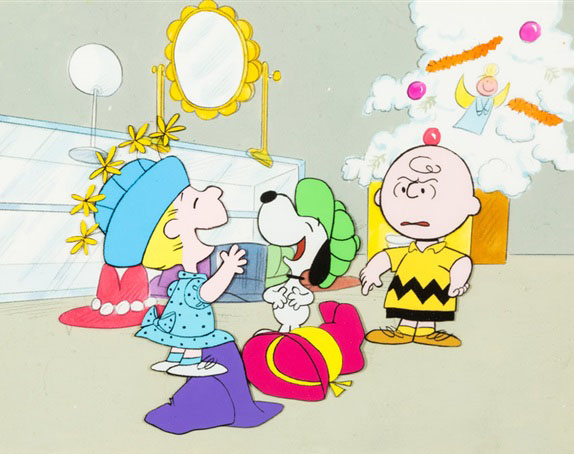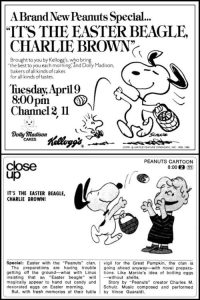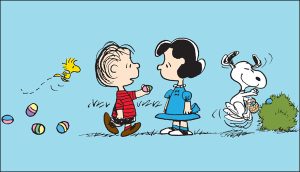



There’s a scene toward the end of It’s The Easter Beagle, Charlie Brown, where Peppermint Patty says, “I’ve seen this happen on holidays before. You look forward to being real happy, and then something happens that spoils it all.” She’s not only speaking for herself and most of the characters in the special but also for the audience watching it at home.
 When It’s The Easter Beagle, Charlie Brown aired in 1974, Charles Schulz’s beloved comic strip Peanuts had left its indelible impression on Christmas, Halloween, and Thanksgiving. As in those other holidays in the world of Charlie Brown and company, there was no doubt that Easter also wouldn’t be perfect, but perfect messages would be expressed.
When It’s The Easter Beagle, Charlie Brown aired in 1974, Charles Schulz’s beloved comic strip Peanuts had left its indelible impression on Christmas, Halloween, and Thanksgiving. As in those other holidays in the world of Charlie Brown and company, there was no doubt that Easter also wouldn’t be perfect, but perfect messages would be expressed.
Like many Peanuts specials, It’s The Easter Beagle, Charlie Brown, celebrating its 50th anniversary this spring, found its inspiration in Schulz’s comic panels, where Snoopy had appeared as the Easter Beagle several years prior.
In the documentary Full Bloom: Peanuts at Easter, the special’s executive producer Lee Mendelson remembered: “The way we created Easter Beagle was similar to the way we created all 45 specials and the series we did later on. Once we picked the topic, in this case, it was Easter and the Easter Beagle, Bill Melendez, the animator, and I would meet with ‘Sparky’ Schulz, and we’d start out, first, thinking about the comic strips that had already dealt with it, and if they could be a basis for the show, or how we could expand from the comics.”
It’s The Easter Beagle, Charlie Brown opens with a unique, humorous, Peanuts-esque take on coloring Easter eggs. Marcie arrives at Peppermint Patty’s house for the tradition of dying the eggs, but instead of hard-boiling them, Marcie fries the eggs. This gag continues throughout the special as Marcie continually misunderstands, later putting the eggs in a waffle iron, toaster, and oven and, when finally, about to boil them, cracks them open into the water.
 Meanwhile, Charlie Brown, Sally, Linus, and Lucy are heading to the store. Sally needs new shoes, and Lucy needs to buy eggs and Easter baskets. Returning to some “Great Pumpkin”-like personal beliefs, Linus tells his sister not to bother, announcing that the “Easter Beagle” will arrive on Easter Sunday and bring everything. To this, Sally replies cynically, “That sounds faintly familiar.”
Meanwhile, Charlie Brown, Sally, Linus, and Lucy are heading to the store. Sally needs new shoes, and Lucy needs to buy eggs and Easter baskets. Returning to some “Great Pumpkin”-like personal beliefs, Linus tells his sister not to bother, announcing that the “Easter Beagle” will arrive on Easter Sunday and bring everything. To this, Sally replies cynically, “That sounds faintly familiar.”
Charlie Brown and the gang head out to the store and meet with Peppermint Patty and Marcie. As they make their way through the large superstore, there are not-so-subtle comments on the commercialism of the holidays. Except here, much like A Charlie Brown Christmas, the yuletide season is in the satirical spotlight.
Signs are plastered everywhere, announcing that the store’s Christmas sale is already happening – “Only 246 Days Until Christmas!” – while gaudy Christmas trees and decorations are splashed everywhere.
 While in the store, Snoopy looks inside a panoramic Easter egg, at an Easter scene filled with bunnies and then imagines himself dancing with them against a very springtime background in a moment of fanciful animation.
While in the store, Snoopy looks inside a panoramic Easter egg, at an Easter scene filled with bunnies and then imagines himself dancing with them against a very springtime background in a moment of fanciful animation.
There’s another subplot in Easter Beagle, during which Snoopy assists Woodstock with moving into a new birdhouse, which is decked out as an oh-so-70s bachelor pad, complete with a recliner, psychedelic posters on the wall and a (then) state-of-the-art stereo system.
Meanwhile, Lucy decides that she is going to hide all of the eggs for the Easter egg hunt. “Easter is very simple,” she says. “You paint the eggs. You hide the eggs. And, you find the eggs. And you know who is going to find the eggs? Me! Because I’m the one who is going to hide them!” However, Snoopy follows and snatches each egg as Lucy hides it.
It all culminates on Easter morning, when Linus finally gets a reprise for the Great Pumpkin, as The Easter Beagle (Snoopy) makes his appearance, dancing through the neighborhood with his basket, giving out all of Lucy’s eggs to everyone (except poor Charlie Brown, of course).
 Marcie finally seems to grasp Easter eggs, understanding that once you receive one, you can sprinkle it with salt and eat it, which she does…shell and all.
Marcie finally seems to grasp Easter eggs, understanding that once you receive one, you can sprinkle it with salt and eat it, which she does…shell and all.
As the special ends, it’s ten weeks after Easter, and Lucy is still angry at Snoopy for swiping all of her eggs. She decides to go out to his doghouse and confront him, but Snoopy kisses Lucy, providing a happy holiday ending.
In addition to Charles Schulz’s humor and perspective, It’s The Easter Beagle, Charlie Brown works so well because all of the same talents who brought us the other classic specials were involved.
 In addition to Mendelson and Melendez as executive producer and producer, respectively, Phil Roman, who directed several other popular Peanuts specials, including those for Thanksgiving and Valentine’s Day, was at the helm for Easter Beagle.
In addition to Mendelson and Melendez as executive producer and producer, respectively, Phil Roman, who directed several other popular Peanuts specials, including those for Thanksgiving and Valentine’s Day, was at the helm for Easter Beagle.
The special’s animation team, including legends such as Don Lusk and Bill Littlejohn, brought life and personality to a number of sequences, including those humorous pantomime moments between Snoopy and Woodstock.
Easter Beagle’s design team, Evert Brown, Bernard Gruver, Frank Smith, and Dean Spille, brought bright and lovely springtime colors to all the backgrounds, particularly the sequence involving Snoopy’s spirited dance with the bunnies.
Weaving through all of this is the usual, comforting jazz score by Vince Guaraldi, who created iconic music for a number of the Peanuts specials and, in Easter Beagle, also laces in lilting music that’s perfect for spring.
Originally airing on CBS on April 9, 1974, It’s The Easter Beagle, Charlie Brown continued to air on CBS for every Easter season through 2000. It also earned an Emmy Nomination for Outstanding Children’s Special.
 The special moved to ABC from 2001 through 2006. When the special aired again in 2008, thirty-four years after its debut, It’s The Easter Beagle, Charlie Brown came in fourth place in the ratings, behind such hit shows as American Idol, NCIS, and The Biggest Loser.
The special moved to ABC from 2001 through 2006. When the special aired again in 2008, thirty-four years after its debut, It’s The Easter Beagle, Charlie Brown came in fourth place in the ratings, behind such hit shows as American Idol, NCIS, and The Biggest Loser.
It was more proof of the special’s enduring appeal and how, fifty years later, it has become linked to the holiday it celebrated, like so many other Peanuts TV specials.
Mendelson attributed the popularity of It’s The Easter Beagle, Charlie Brown to the enduring appeal and relatability of all of Charles Schulz’s work: “There’s always a new generation coming along that is struggling with the painting of the eggs, or whatever holiday happens to be there. And, I think that’s why it’s remained one of our most popular shows.”